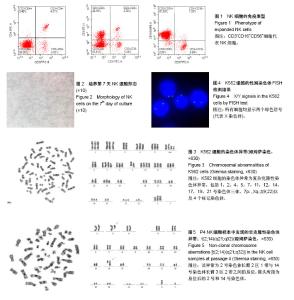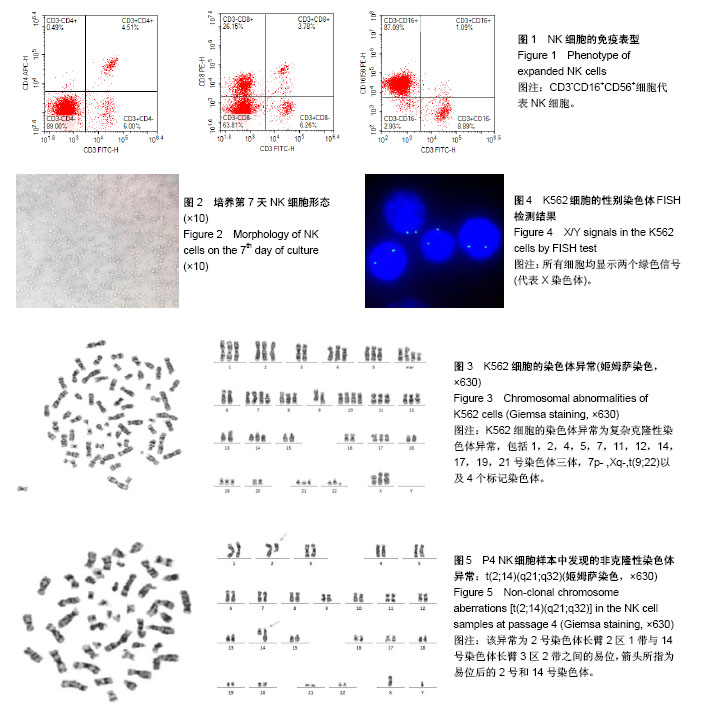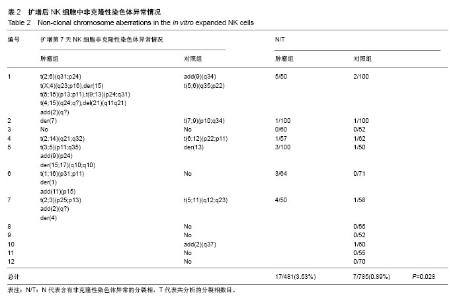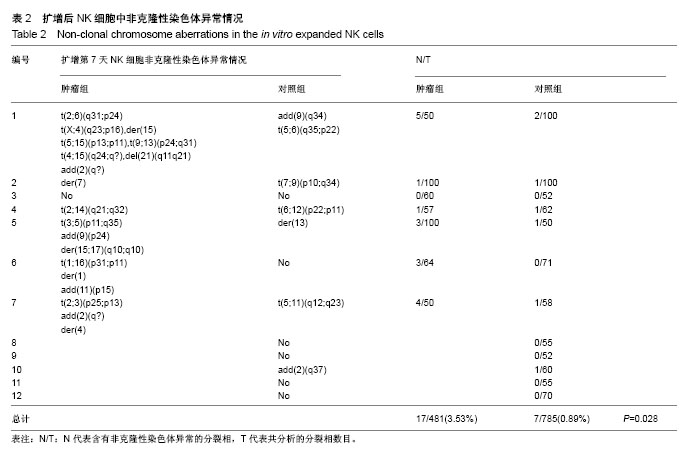Chinese Journal of Tissue Engineering Research ›› 2018, Vol. 22 ›› Issue (33): 5362-5367.doi: 10.3969/j.issn.2095-4344.0645
Previous Articles Next Articles
The characteristics and significance of non-clonal chromosome aberrations in the in vitro expanded NK cells
Li Yu-long, Huang Zhou-feng, Zhang Lei, Wu Cheng-ye, Cheng Wei, Dong Xiao-yan, Zhu Zun-min, Sun Kai
- Institute of Haematology, Henan Provincial People’s Hospital, Zhengzhou 450002, Henan Province, China
-
Revised:2018-06-04Online:2018-11-28Published:2018-11-28 -
Contact:Sun Kai, MD, Chief physician, Institute of Haematology, Henan Provincial People’s Hospital, Zhengzhou 450002,Henan Province, China -
About author:Li Yu-long, Master, Associate chief technician, Institute of Haematology, Henan Provincial People’s Hospital, Zhengzhou 450002, Henan Province, China -
Supported by:Fundamental and Frontier Project Fund of Henan Provincial Science and Technology Department, No. 142300410078
CLC Number:
Cite this article
Li Yu-long, Huang Zhou-feng, Zhang Lei, Wu Cheng-ye, Cheng Wei, Dong Xiao-yan, Zhu Zun-min, Sun Kai. The characteristics and significance of non-clonal chromosome aberrations in the in vitro expanded NK cells[J]. Chinese Journal of Tissue Engineering Research, 2018, 22(33): 5362-5367.
share this article

2.1 NK细胞的免疫表型验证 目前,CD3-CD16+CD56+被认为是NK细胞的表面标志。在培养的第7天,80.5%-91.2%的细胞呈现CD3-CD16+CD56+表型(图1),人工化抗原递呈细胞成功刺激了NK细胞的增殖(图2)。 2.2 肿瘤组和对照组NK细胞中检出非克隆性染色体异常人数及非克隆性染色体异常发生频率比较 人工化抗原递呈细胞的核型为复杂的克隆性染色体异常(图3),而所有NK细胞样本中均未检测到克隆性染色体异常。FISH检测人工化抗原递呈细胞性别染色体为两个绿色X信号(图4),表示K562细胞来自女性,因此异常的男性核型不可能源自人工化抗原递呈细胞污染。 在7例肿瘤患者的NK细胞样本中,6例检测出非克隆性染色体异常(图5),而在12例健康志愿者中,6例检出非克隆性染色体异常,两者相比差异无显著性意义(85.71% vs. 50%,P=0.173)。 在肿瘤组中,共分析481个中期分裂相,发现含有非克隆性染色体异常的分裂相17个;在健康组中,共分析785个中期分裂相,发现含非克隆性染色体异常的分裂相7个,两者相比差异有显著性意义[3.53%(17/481) vs. 0.89% (7/785),Z=-2.212,P=0.028]。 2.3 有/无放化疗史的个体NK细胞中非克隆性染色体异常的频率比较 4例有放化疗病史的患者,264个中期分裂相中发现含有非克隆性染色体异常的分裂相15个,明显高于对照组[5.68%(15/264)vs.0.89%(7/785),Z=-2.991,P=0.003]及初诊肿瘤患者[5.68%(15/264) vs. 0.92%(2/217),Z=-2.121,P=0.034],而初诊肿瘤患者与对照组非克隆性染色体异常的频率差异无显著性意义[0.92% (2/217) vs. 0.89%(7/785),Z=-0.229,P=0.819],见表2。 2.4 肿瘤组与对照组NK细胞γ-干扰素表达水平比较 培养后肿瘤组与对照组NK细胞表达γ-干扰素水平差异无显著性意义[(28.41±3.54)% vs. (31.88±7.50)%,F=0.846,P=0.371],接受过放化疗的患者与对照组以及初诊肿瘤患者相比,差异亦无显著性意义[(26.4±3.21)% vs. (31.88±7.50)%,F=2.847,P=0.114;(26.4±3.21)% vs. (32.1±5.63)%,F=2.135,P=0.204]。 2.5 NK细胞中非克隆性染色体异常与γ-干扰素分泌水平相关性分析 肿瘤组和对照组NK细胞中,非克隆性染色体异常与γ-干扰素表达水平均无明显相关性(r值分别为-0.472,-0.557,P值分别为0.285,0.06)。"

| [1] Barao I, Murphy WJ.The immunobiology of natural killer cells and bone marrow allograft rejection.Biol Blood Marrow Transplant. 2003;9(12): 727-741.[2] Denman CJ, Senyukov VV, Somanchi SS, et al. Membrane-bound IL-21 promotes sustained ex vivo proliferation of human natural killer cells.PLoS One. 2012;7(1):e30264.[3] Hare I, Gencheva M, Evans R, et al. In Vitro Expansion of Bone Marrow Derived Mesenchymal Stem Cells Alters DNA Double Strand Break Repair of Etoposide Induced DNA Damage.Stem Cells Int. 2016;2016:8270464.[4] Capelli C, Pedrini O, Cassina G, et al. Frequent occurrence of non-malignant genetic alterations in clinical grade mesenchymal stromal cells expanded for cell therapy protocols.Haematologica. 2014;99(6):e94-97.[5] SchafferLG, McGowan-JordanJ, SchmidM, et al. ISCN 2013: An International System for Human Cytogenetic Nomenclature Karger, Basel.2013.[6] Heng HH, Regan SM, Liu G, et al. Why it is crucial to analyze non clonal chromosome aberrations or NCCAs. Mol Cytogenet. 2016;9:15.[7] Mayshar Y, Ben-David U, Lavon N, et al. Identification and classification of chromosomal aberrations in human induced pluripotent stem cells.Cell Stem Cell. 2010;7(4):521-531.[8] Barkholt L, Flory E, Jekerle V, et al. Risk of tumorigenicity in mesenchymal stromal cell-based therapies--bridging scientific observations and regulatory viewpoints.Cytotherapy. 2013;15(7): 753-759. [9] Fujisaki H, Kakuda H, Shimasaki N, et al. Expansion of highly cytotoxic human natural killer cells for cancer cell therapy.Cancer Res. 2009; 69(9):4010-4017.[10] Pittari G, Filippini P, Gentilcore G, et al. Revving up Natural Killer Cells and Cytokine-Induced Killer Cells Against Hematological Malignancies. Front Immunol. 2015;6:230.[11] Lozzio CB, Lozzio BB.Human chronic myelogenous leukemia cell-line with positive Philadelphia chromosome.Blood. 1975;45(3):321-334.[12] Bochtler T, Fröhling S, Krämer A.Role of chromosomal aberrations in clonal diversity and progression of acute myeloid leukemia.Leukemia. 2015;29(6):1243-1252.[13] Bonassi S, Hagmar L, Strömberg U, et al. Chromosomal aberrations in lymphocytes predict human cancer independently of exposure to carcinogens. European Study Group on Cytogenetic Biomarkers and Health.Cancer Res. 2000;60(6):1619-1625.[14] Scott D, Barber JB, Spreadborough AR, et al. Increased chromosomal radiosensitivity in breast cancer patients: a comparison of two assays. Int J Radiat Biol. 1999;75(1):1-10.[15] Shen KC, Heng H, Wang Y, et al. ATM and p21 cooperate to suppress aneuploidy and subsequent tumor development. Cancer Res. 2005; 65(19):8747-8753.[16] Mavrogenis AF, Patapis P, Papaparaskeva KT, et al. Extraskeletal myxoid chondrosarcoma of the perineum. Orthopedics. 2009;32(3):216.[17] Cho TJ, Kim OH, Choi IH, et al. A dominant mesomelic dysplasia associated with a 1.0-Mb microduplication of HOXD gene cluster at 2q31.1.J Med Genet. 2010;47(9):638-639.[18] Logan GE, Mor-Vaknin N, Braunschweig T, et al. DEK oncogene expression during normal hematopoiesis and in Acute Myeloid Leukemia (AML).Blood Cells Mol Dis. 2015;54(1):123-131.[19] Ohanian M, Bueso-Ramos C, Ok CY, et al. Acute myeloid leukemia with MYC rearrangement and JAK2 V617F mutation. Cancer Genet. 2015;208(11):571-574.[20] Prokopiou C, Koumas S, Neokleous N, et al. SET-NUP214 rearrangement in isolation is insufficient to induce leukemia: a single center experience.Leuk Lymphoma. 2015:1-2.[21] Qiu SW, Wan YL, Wang M, et al. Effects of NPM1 gene expression on acute myeloid leukemia cell lines and its mechanism.Zhonghua Xue Ye Xue Za Zhi. 2017;38(11):940-944.[22] Sharpless NE, Ferguson DO, O'Hagan RC, et al. Impaired nonhomologous end-joining provokes soft tissue sarcomas harboring chromosomal translocations, amplifications, and deletions.Mol Cell. 2001;8(6):1187-1196.[23] Kolusayin Ozar MO, Orta T.The use of chromosome aberrations in predicting breast cancer risk.J Exp Clin Cancer Res. 2005;24(2): 217-222.[24] Ye CJ, Stevens JB, Liu G, et al. Genome based cell population heterogeneity promotes tumorigenicity: the evolutionary mechanism of cancer.J Cell Physiol. 2009;219(2):288-300.[25] Fujisaki H, Kakuda H, Imai C, et al. Replicative potential of human natural killer cells.Br J Haematol. 2009;145(5):606-613.[26] Fang F, Xiao W, Tian Z.NK cell-based immunotherapy for cancer. Semin Immunol. 2017;31:37-54.[27] 区大卫,蔡体育,李端,等. 干扰素在体外对放疗后鼻咽癌病人自然杀伤细胞功能的影响[J]. 中山医学院学报,1984,5(2):40-44.[28] 刘晓静,龚春香,范敏其,等. 放疗对食管癌患者血清可溶性MI CA含量及外周血NK细胞功能的影响[J]. 徐州医学院学报, 2009,29(8):508-511.[29] McGinnes K, Florence J, Penny R.The effect of radiotherapy on the natural killer (NK)-cell activity of cancer patients.J Clin Immunol. 1987;7(3):210-217.[30] Ghiringhelli F, Menard C, Puig PE, et al. Metronomic cyclophosphamide regimen selectively depletes CD4+CD25+ regulatory T cells and restores T and NK effector functions in end stage cancer patients.Cancer Immunol Immunother. 2007;56(5): 641-648.[31] Koda K, Saito N, Oda K, et al. Natural killer cell activity and distant metastasis in rectal cancers treated surgically with and without neoadjuvant chemoradiotherapy.J Am Coll Surg. 2003;197(2): 254-260.[32] Roos WP, Kaina B.DNA damage-induced cell death: from specific DNA lesions to the DNA damage response and apoptosis.Cancer Lett. 2013;332(2):237-248. |
| [1] | Zhang Tongtong, Wang Zhonghua, Wen Jie, Song Yuxin, Liu Lin. Application of three-dimensional printing model in surgical resection and reconstruction of cervical tumor [J]. Chinese Journal of Tissue Engineering Research, 2021, 25(9): 1335-1339. |
| [2] | Zeng Yanhua, Hao Yanlei. In vitro culture and purification of Schwann cells: a systematic review [J]. Chinese Journal of Tissue Engineering Research, 2021, 25(7): 1135-1141. |
| [3] | Xu Dongzi, Zhang Ting, Ouyang Zhaolian. The global competitive situation of cardiac tissue engineering based on patent analysis [J]. Chinese Journal of Tissue Engineering Research, 2021, 25(5): 807-812. |
| [4] | Wu Zijian, Hu Zhaoduan, Xie Youqiong, Wang Feng, Li Jia, Li Bocun, Cai Guowei, Peng Rui. Three-dimensional printing technology and bone tissue engineering research: literature metrology and visual analysis of research hotspots [J]. Chinese Journal of Tissue Engineering Research, 2021, 25(4): 564-569. |
| [5] | Chang Wenliao, Zhao Jie, Sun Xiaoliang, Wang Kun, Wu Guofeng, Zhou Jian, Li Shuxiang, Sun Han. Material selection, theoretical design and biomimetic function of artificial periosteum [J]. Chinese Journal of Tissue Engineering Research, 2021, 25(4): 600-606. |
| [6] | Liu Fei, Cui Yutao, Liu He. Advantages and problems of local antibiotic delivery system in the treatment of osteomyelitis [J]. Chinese Journal of Tissue Engineering Research, 2021, 25(4): 614-620. |
| [7] | Li Xiaozhuang, Duan Hao, Wang Weizhou, Tang Zhihong, Wang Yanghao, He Fei. Application of bone tissue engineering materials in the treatment of bone defect diseases in vivo [J]. Chinese Journal of Tissue Engineering Research, 2021, 25(4): 626-631. |
| [8] | Zhang Zhenkun, Li Zhe, Li Ya, Wang Yingying, Wang Yaping, Zhou Xinkui, Ma Shanshan, Guan Fangxia. Application of alginate based hydrogels/dressings in wound healing: sustained, dynamic and sequential release [J]. Chinese Journal of Tissue Engineering Research, 2021, 25(4): 638-643. |
| [9] | Chen Jiana, Qiu Yanling, Nie Minhai, Liu Xuqian. Tissue engineering scaffolds in repairing oral and maxillofacial soft tissue defects [J]. Chinese Journal of Tissue Engineering Research, 2021, 25(4): 644-650. |
| [10] | Xing Hao, Zhang Yonghong, Wang Dong. Advantages and disadvantages of repairing large-segment bone defect [J]. Chinese Journal of Tissue Engineering Research, 2021, 25(3): 426-430. |
| [11] | Chen Siqi, Xian Debin, Xu Rongsheng, Qin Zhongjie, Zhang Lei, Xia Delin. Effects of bone marrow mesenchymal stem cells and human umbilical vein endothelial cells combined with hydroxyapatite-tricalcium phosphate scaffolds on early angiogenesis in skull defect repair in rats [J]. Chinese Journal of Tissue Engineering Research, 2021, 25(22): 3458-3465. |
| [12] | Wang Hao, Chen Mingxue, Li Junkang, Luo Xujiang, Peng Liqing, Li Huo, Huang Bo, Tian Guangzhao, Liu Shuyun, Sui Xiang, Huang Jingxiang, Guo Quanyi, Lu Xiaobo. Decellularized porcine skin matrix for tissue-engineered meniscus scaffold [J]. Chinese Journal of Tissue Engineering Research, 2021, 25(22): 3473-3478. |
| [13] | Mo Jianling, He Shaoru, Feng Bowen, Jian Minqiao, Zhang Xiaohui, Liu Caisheng, Liang Yijing, Liu Yumei, Chen Liang, Zhou Haiyu, Liu Yanhui. Forming prevascularized cell sheets and the expression of angiogenesis-related factors [J]. Chinese Journal of Tissue Engineering Research, 2021, 25(22): 3479-3486. |
| [14] | Liu Chang, Li Datong, Liu Yuan, Kong Lingbo, Guo Rui, Yang Lixue, Hao Dingjun, He Baorong. Poor efficacy after vertebral augmentation surgery of acute symptomatic thoracolumbar osteoporotic compression fracture: relationship with bone cement, bone mineral density, and adjacent fractures [J]. Chinese Journal of Tissue Engineering Research, 2021, 25(22): 3510-3516. |
| [15] | Liu Liyong, Zhou Lei. Research and development status and development trend of hydrogel in tissue engineering based on patent information [J]. Chinese Journal of Tissue Engineering Research, 2021, 25(22): 3527-3533. |
| Viewed | ||||||
|
Full text |
|
|||||
|
Abstract |
|
|||||

